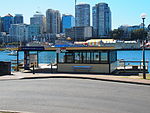Division of East Sydney
The Division of East Sydney was an Australian Electoral Division in New South Wales. The division was created in 1900 and was one of the original 75 divisions contested at the first federal election. It was abolished in 1969. It was named for the suburb of East Sydney. It was located in the inner eastern suburbs of Sydney, including Darlinghurst, Paddington, Redfern, Surry Hills and Waverley. From 1901 to 1955 the division included Lord Howe Island. After 1910 East Sydney was usually a safe seat for the Australian Labor Party. In the 1930s it was a stronghold of Lang Labor. Its most prominent members were Sir George Reid, who was Prime Minister of Australia in 1904-05, and Eddie Ward, a long-serving Labor member and Cabinet minister.
Excerpt from the Wikipedia article Division of East Sydney (License: CC BY-SA 3.0, Authors).Division of East Sydney
Blues Point Road, Sydney McMahons Point
Geographical coordinates (GPS) Address Nearby Places Show on map
Geographical coordinates (GPS)
| Latitude | Longitude |
|---|---|
| N -33.85 ° | E 151.2 ° |
Address
Blues Point Tower
Blues Point Road
2060 Sydney, McMahons Point
New South Wales, Australia
Open on Google Maps









